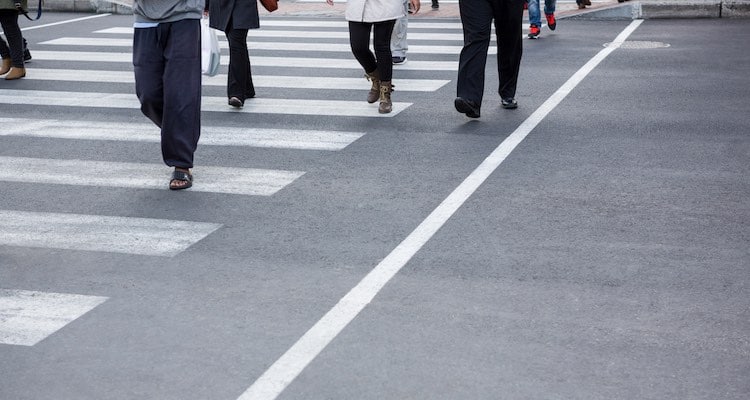
If you’re like most people, you probably feel pretty safe on foot, whether you’re walking to the convenience store at the corner or out for a sunny afternoon stroll with a friend. In Florida, though, that confidence may be misplaced. Last year, Florida made news by claiming the unwanted title of “most dangerous state for pedestrians.” That title was awarded by national community organization Smart Growth America in its 2019 report, Dangerous by Design. The danger wasn’t new, though: Florida claimed the top spot in 2016, too, and risk assessments are based on data spanning a 10-year period.
The risks aren’t all specific to Florida: pedestrian fatalities are up around the country. According to the Governor’s Highway Safety Administration (GHSA), more than 6,200 pedestrians were killed in traffic in 2018. Some reasons suggested for the increase include:
- An increase in the number of people walking and the frequency with which they travel by foot Dangerous driving habits such as speeding, distracted driving, driving while fatigued, and driving under the influence
- An increase in the number of SUVs on the road
But, some factors help to explain why both the number of pedestrian fatalities and the rate of pedestrian fatalities in Florida is so high.
First, and most obviously, Florida is a warm weather state. That means people are more likely to walk year round, versus only during part of the year in northern states. In fact, nine of the 10 states deemed most dangerous for pedestrians in the report referenced above are warm weather southern states.
Another likely contributing factor is the rapid increase in the Florida population. U.S. Census data suggests that more than 600 people are moving to Florida each day. Not only does the population explosion mean there are more people out walking, it also means more cars on the road and more people generally using streets and sidewalks that may not have been built for current traffic levels. And, the Smart Growth America report suggests that Florida officials are aiming low when it comes to reducing the risk.
Minimizing Risk of Pedestrian Accidents
Awareness of the risk to pedestrians is the first step toward keeping walkers and joggers safe. That means extra care from the pedestrians themselves, from motorists, from bicyclists, and even from others who may impact traffic safety like property owners who may want to re-think signage or other obstacles to a clear line of vision.
Tips for Pedestrians
The first and most important safety measure for pedestrians is simply to be alert. Believe it or not, distracted walking is a thing–and the National Safety Council says it’s on the rise. That means refraining from texting while walking and avoiding headphones that block out traffic sounds.
Other ways pedestrians can stay safer include:
- Avoid walking at night, and take special care if you must. The vast majority of pedestrian fatalities happen at night, when visibility is lower.
- Make yourself visible, whether that means reflective gear at night or brighter colors when you’re out walking or running during the day.
- Obey traffic signals and use crosswalks rather than stepping out into the street mid-block, where drivers are less likely to be watching out for you.
- Walk on the sidewalk whenever possible, and walk facing traffic when you must walk on the shoulder of the road.
- Come to a full stop and look both ways before crossing a street. This important safety measure we all learned in childhood often loses out to hurry or distraction.
Tips for Drivers
Pedestrians can and should take precautions to protect themselves on the road. But, motor vehicles are larger, faster, and far more dangerous than a person on foot. So, drivers must do their part to minimize the risks to the pedestrians they share the roads with.
As with pedestrians, the most important thing a driver can do is to remain alert and on the lookout for pedestrians, bicyclists, and others who may be on the road. This is especially important as warmer weather approaches: people are more likely to walk both for pleasure and transportation in the warmer weather, there will be more runners on the road, and more children will be playing outside, walking to school, and walking to friends’ houses.
Other specific tips for pedestrian safety are similar to those any safe driver should employ, but with some special considerations:
- Obey speed limits and slow down where visibility is low or there is a lot of activity. Slowing down not only reduces the risk of hitting a pedestrian, but reduces the likelihood that a pedestrian struck will be seriously injured or killed.
- Don’t drive under the influence. Even a small amount of impairment slows reaction time, which may be the difference between life and death if a pedestrian steps into your path unexpectedly.
- Stay off the road if you haven’t had enough sleep. As a nation, we’re chronically sleep deprived, but that’s particularly dangerous on the road. Some researchers have suggested that driving without adequate sleep is as dangerous as driving under the influence.
Following these basic safety rules doesn’t just benefit pedestrians. Drivers who fail to obey the law or take reasonable precautions for the safety of pedestrians on the road may be liable for any injuries they cause, and may even be charged criminally.
Harrell & Harrell Helps Victims of Pedestrian Accidents
If you have been injured by a motor vehicle while walking or have lost a loved one to a pedestrian accident, you may be entitled to compensation to help you recover and rebuild. You may be able to recover damages even if you were partly responsible for the accident.
To learn more about your rights and options after a pedestrian accident and to find out how we may be able to help, schedule a free consultation with one of our accident attorneys right now. Just call 800-251-1111 or click in the lower right-hand corner of this page to chat.
